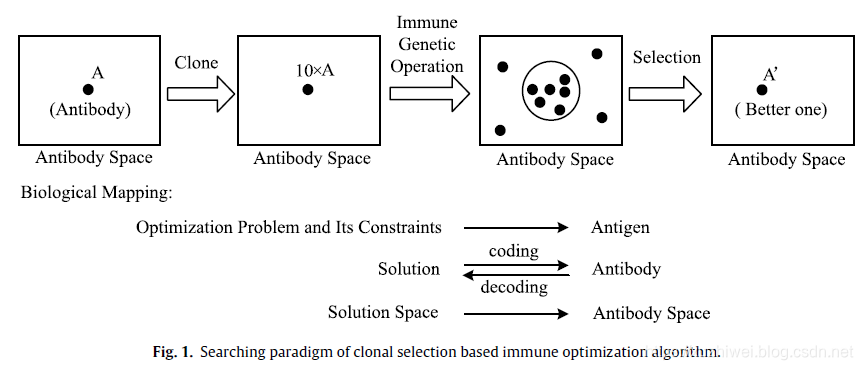不完全免疫算法简介IMADE–AIS学习笔记5
觉得有用的话,欢迎一起讨论相互学习~
多目标优化
An immune MOP algorithm with DE inspired recombination
参考文献
An immune multi-objective optimization algorithm with differentialevolution inspired recombination, Applied Soft Computing 29 (2015) 395–410
摘要
- According to the regularity of continuous multi-objective optimization problems (MOPs), an immunemulti-objective optimization algorithm with differential evolution inspired recombination (IMADE) isproposed in this paper. In the proposed IMADE, the novel recombination provides two types of candidatesearching directions by taking three recombination parents which distribute along the current Pareto set(PS) within a local area. One of the searching direction provides guidance for finding new points alongthe current PS, and the other redirects the search away from the current PS and moves towards the targetPS. Under the background of the SBX (Simulated binary crossover) recombination which performs localsearch combined with random search near the recombination parents, the new recombination operatorutilizes the regularity of continuous MOPs and the distributions of current population, which helps IMADEmaintain a more uniformly distributed PF and converge much faster.Experimental results have demon-strated that IMADE outperforms or performs similarly to NSGAII, NNIA, PESAII and OWMOSaDE in termsof solution quality on most of the ten testing MOPs. IMADE converges faster than NSGAII and OWMOSaDE.The efficiency of the proposed DE recombination and the contributions of DE and SBX recombination to IMADE have also been experimentally investigated in this work.
AIS
- Artificial immune system (AIS) is a new type of computational system whichis inspired by the theoretical immunology and observed immune functions, princi-ples and models. In recent years, AIS has received a significant amount of interestfrom researchers and industrial sponsors. It has been used to solve various types ofproblems such as fault diagnosis, computer security, pattern recognition, schedulingand optimization [27]. In the field of immune optimization computing, more andmore researches indicate that, comparing with EAs, artificial immune algorithmscan maintain better population diversity and thus they do not easily fall in localoptima. Recently, Coello proposed the multi-objective immune system algorithm(MISA) [28] based on the immune clonal selection principle. Jiao, Gong and Yanget al. proposed the multi-objective immune algorithms NNIA [19] and AHM [20].AIS has drawn the attention of many researchers on MOPs solving, resulting in a lotof multi-objective artificial immune algorithms with improved performance. In thiswork, we present an immune inspired multi-objective optimization approach witha novel recombination operator which is enlightened by differential evolution.
Point
- This paper provides an immune multi-objective optimization algorithm with differential evolution inspired recombination (IMADE). In IMADE, the fitness value of each non-dominated individual is assigned according to its crowding-distance [10].Thus, IMADE pays more attention to the less-crowded regions of current PF in a sin-gle iteration. In IMADE, a novel DE inspired recombination is designed according tothe features of the MOPs. In the newly designed recombination operator, two typesof searching directions which explore diversity along current PS and move towardsthe true PS are determined according to the other two neighboring individuals in the current PS.
Related work
- Optimization is one of the most important application fields of artificial immune systems. In the view of immune optimization computing, the process of the human immune system recognizingand responding to the antigens can be considered as a space search-ing procedure with the aim of finding a best-matching antibody in the antibody space. If we consider the optimization problem and its constraints as the antigen, and the candidate solution of the targetproblem as the antibody, the process of the immune optimization algorithm finding high quality solutions in the solution space can be mapped to the similar process of human immune recognitionand immune response.
- The immune clonal selection principle [37] proposed by Burnetin 1958 is a widely accepted model explaining how the immune sys-tem searches for antibodies which match the antigen best and thenresponds to infection. Based on this principle, Castro pioneered the clonal selection algorithm (CSA) [38] for the optimizationproblem. This work established the framework of the searchingparadigm based on immune clonal selection and affinity matura-tion by hyper-mutation.
- Fig. 1 presents the searching paradigm of clonal selection basedimmune optimization algorithm. It illustrates how an instance anti-body in the antibody population changes from one individual to abetter one in one iteration. In this iteration flow, there are threeimportant operations, the clone operation, the immune geneticoperation and the selection operation. The clone operation willdecide how many offspring the operated antibody proliferates. Theclone size (10 for example in Fig. 1) is usually proportional to theantibody’s affinity. The immune genetic operation which consists ofmutation and recombination will determine how the antibody pop-ulation evolves and maturates. Usually, this operation is speciallydesigned according to the target problem and current antibodypopulation. The selection operation will decide which offspringantibody will survive. Usually the antibody with high affinity ismore likely to be retained.
- For solving MOPs, MISA [28] may be the first attempt to solvegeneral MOPs using the immune clonal selection paradigm. InMISA, the decision variables of MOPs are binary coded which hasbeen proved to be less efficient than the real-coding strategy whendealing with MOPs with complex and high dimensional decisionspace. In 2005, Cutello et al. [39] modified the (1+1)-PAES using thetwo immune inspired operators, cloning and hyper-mutation, andapplied the improved PAES to solve the protein structure predic-tion problem. More recently, Gong et al. proposed NNIA [19] usingthe clonal selection paradigm and the more efficient real-codingstrategy. However, the immune genetic operation of NNIA employsthe simulated binary crossover (SBX) [40] recombination whichinclines to random search rather than to consider the features ofMOPs such as its decision space and the shape of its true PS. Toremedy this, we propose a DE based recombination operator whichconsiders the features of MOPs to enhance the searching ability ofthe immune clonal selection based optimization algorithm.






















 264
264











 被折叠的 条评论
为什么被折叠?
被折叠的 条评论
为什么被折叠?








